As a parent of two little angels (/devils), I do not feel any shame admitting that parenting is hard and sometimes I feel completely lost. There are just so many different situations, milestones, and choices you have to make.
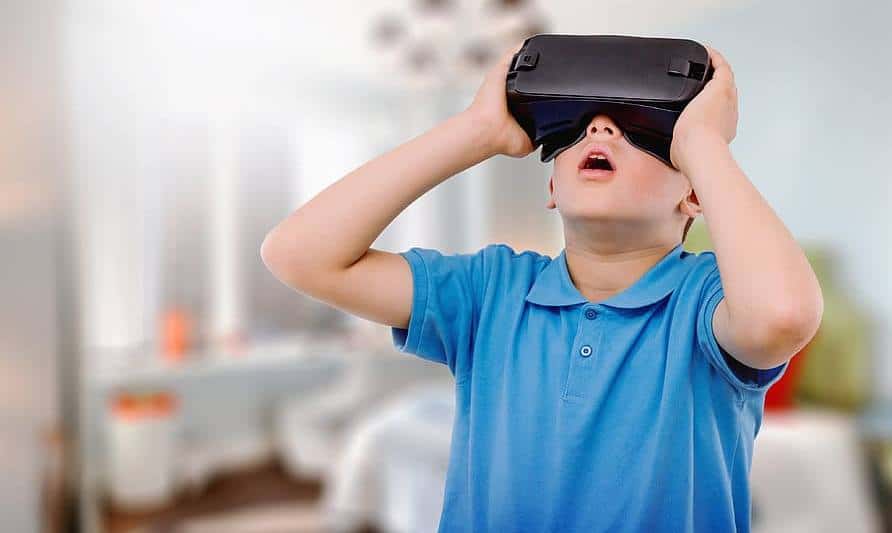
Children and their relation to technology is one of the choices. To be honest, it is such a complex topic with different nuances, where there probably is no single right or wrong answer
This article aims to help you gain more knowledge about virtual reality, its suitability for kids and the possible risks and health effects it might have. Hopefully, after reading you will be able to devise your own vision and strategy about when and how you are going to let your kids experience VR.
Disclaimer: I am no medical expert. In preparation for my own kids reaching the “VR age”, I gathered information from various scientific researches and articles (listed here) and tried to conclude the material into a single useful guide.
What is Virtual Reality (VR)?
Virtual reality is a computer-generated digital 3D environment where you can interact with the virtual surroundings and objects.
By strapping on a VR headset you no longer see the physical real world. Instead, you are transported into the body of a virtual character (who you control) in a virtual world. The view you get in VR is very similar to the real-life human point of view (POV) perspective.
Depending on the VR game/content, the virtual character mimics your actions and body movement. If you turn your head left, right, up or down, the same will happen in VR. And if you walk in real life, you will also move around in the virtual world.
VR headsets also come with controllers that you hold during the VR experience. This way, your hand movement is tracked and you can for example grab, throw, move and otherwise interact with objects in the virtual world.
To get a better understanding of how this all comes together, see the example video below of a virtual pet gameplay that shows both the real and virtual world recordings at the same time.
VR Age Limit – When is it OK to introduce VR to kids?
With virtual reality gaining more and more momentum and paving its way into our lives, here lies another decision point for parents. What age is OK for children to have a go at VR?
The current consensus among VR manufacturers seems to be that virtual reality should not be used by children under the age of 13. For example, you can find these guidelines from the Oculus and Valve VR headset safety manuals.
VR is a relatively new technology and there is currently very little research done on the long-term effects of VR on (children`s) health. Therefore, a cautious approach from VR manufactures to the age limit is totally understandable.
Where Did the 13+ Age Limit Come From?
The Co-founder and former CEO of Oculus VR, Brendan Iribe, explained the 13+ age limit in the year 2015, prior to their first mainstream headset (Oculus Rift).
Iribe said: “The age of 13 was something that made a lot of sense when we (Oculus) became a part of Facebook, their age is 13 as well. And so we just felt let’s start at 13, let’s evolve the technology more, let’s build more confidence, in the health and safety side of it “
Several years and new products later, the recommended age still remains the same. One of the reasons could then very well be, that “Oculus lead the way” and other VR manufacturers are following.
However, it also shows that VR manufacturers are not certain enough about the safety of VR that they could reduce the recommended age limit for VR headsets.
Is 13+ a Strict Limit? Should You Let Younger Kids Play?
Yes. No. Maybe.
Like with many aspects of parenting, there is no single right or wrong answer. The truth is that there are currently very few studies on the long-term effects of VR on children. This essentially means that if you let your younger children play, you will be putting them in a guinea-pig role.
That being said, with information that is presently available, there is no reason to think that short monitored play sessions will do any harm do your child.
To better understand the possible risks and health considerations of VR and children, let does dive into the topic a bit more deeply.
Is VR Safe For Children? Health Effects & Considerations
Interpupillary Distance (IPD) & Eye Strain
IPD (interpupillary distance) is the distance measured in millimeters between the centers of the pupils of your eyes.

Although the average IPD for people varies quite a lot, one research shows that the vast majority of adults have IPDs in the 50-75 mm range.
Most modern VR headsets work best with an IPD somewhere in the 60-70 mm range. They are built with adults in mind, not children.
The same research also shows some statistics about the IPD of children. From the figure below, it can be seen that a large number of male children fall under the optimal IPD range for VR headsets. The average female children’s IPD is even smaller.
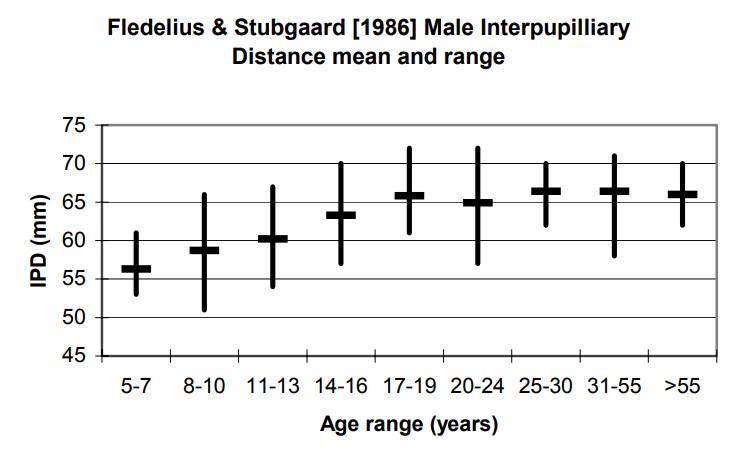
With the mismatch of VR headset and eye IPD measurement, the image will be somewhat blurry and the child`s eyes will be diverging at a different amount in VR than in the real world. This can cause eye strain, headaches and temporary visions problems (if used for hours without a break)
What you can do about it?
- If possible, opt for a VR headset that has manual IPD adjustment and can be set to as low IPD as possible. Currently, the best fit for children seems to be Oculus Quest, which has the lowest setting of 58mm.
- Talk to your child while adjusting the IPD measurement and fit of the headset. Do linear changes and ask if the experience got better or worse for them. Make an effort to understand the experience your child is having and find the sweet spot.
- Make VR sessions short and take frequent breaks.
- During the session, talk to your child and ask about their experience and any discomfort they might have.
Accommodation-Convergence Conflict
Human eyes are a wonderful and complex system. To change the focus on objects at different distances, our eyes use special muscles to either pull or relax the lenses in our eyes. This changes the shape of the lens (shortening or lengthening it) in order to focus light rays properly.
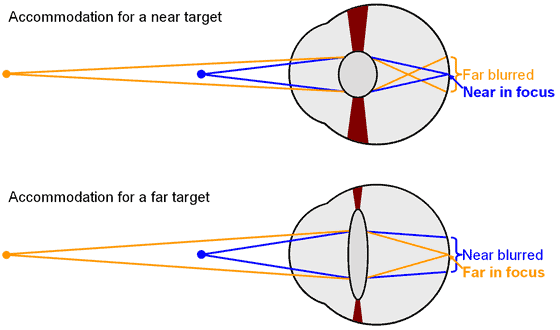
This functionality of the eyes is called Accommodation and it is an important depth cue for objects close to us. Our eyes are also able to move independently, and depending on the need, either focus inwards for objects up close (converging) and then move outwards until parallel (diverging). This is another depth cue that the human eye system uses.
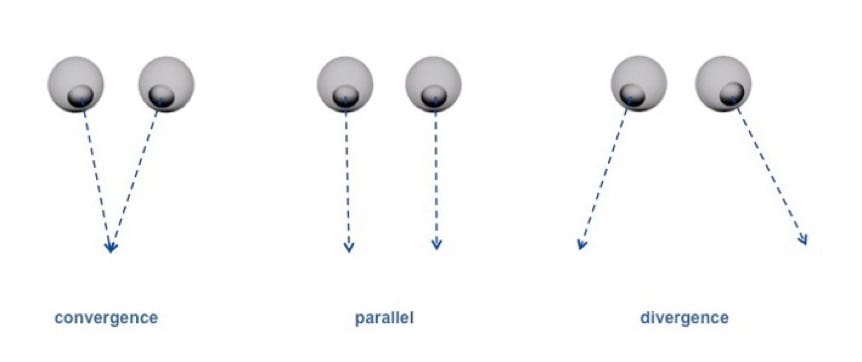
With normal eye function, the accommodation and convergence functionalities work in sync and both do their magic, depending on the distance of the object.
However, with VR things get slightly odd. Even though the screen of a VR headset is physically very close to your eyes, all the objects you see in virtual reality are set at a focal distance of about 2 meters (~7 feet). This visual property is achieved with the lenses in the VR headset and the way they bend the light.
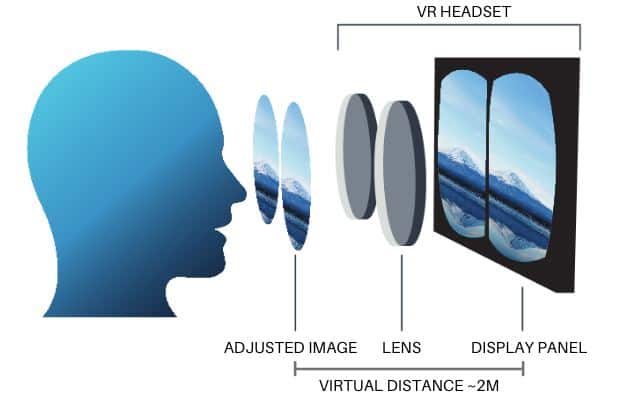
So let does say you see a pet dog in VR, who appears to be approximately 30cm away. Your eyes are converging on a spot (the dog) at 30cm distance away but they are focusing (accommodating) on the screen which is 2m away. This causes a discord that never happens in real life.
For some people, this dissonance causes a “weird” feeling when coming back from VR to “real life” while the eyes are readjusting. It might also cause temporary eye strain and headaches.
Another, more serious hypothetical problem here is that if the developing visual system of a child gets used to not having to flex those muscles to see something in VR (that their brain is telling ought to be very close), it is possible that the eye muscles might lose some amount of strength to flex those lenses.
However, this would probably mean a humongous time spent in VR with little or no breaks. But nevertheless, better safe than sorry. If you are going to let your child use VR, keep the sessions short and make them take frequent breaks.
You can read also related studies on this matter (conducted on adults) from here and here.
Children Unable To Differentiate Reality & Virtual World
Imagine the following. You strap on a VR headset and suddenly find yourself rope-walking between two skyscrapers. You look down and you are so high from the ground that you can barely see some movement on the roads. These appear to be cars.
You suddenly feel a sense of panic taking over you. Your palms are getting wet and you feel your heart pounding as if it was trying to break out from your chest.
However, you then calm yourself down by remembering that you are actually in a room with a VR headset strapped on your face. As adults, we are simultaneously able to hold both the physical as well as the virtual representation of the world in our minds.
However, the developing brains of children work slightly differently. A study from Stanford University found that children aged 6-18 reported higher levels of presence and “realness” of virtual environments, compared with adults aged 19-65.
Another study from Stanford University showed that 50% of children that were exposed to a virtual reality experience, remembered the event as being real after a week had passed.
What this means is that children are more likely to be influenced by both positive (social interaction and education) as well as negative experiences (violence, frightening) they get in the virtual environment.
It is important to note here that children are also more susceptible to the content they get from other sources (TV, mobile, …). With virtual reality, due to the 3D immersive representation, the feeling is just stronger and more realistic.
What can you do about it?
- Start with less stimulating and easier experiences that let your child get used to VR
- Before letting your children play a VR game/experience, test it out yourself. See if it would be suitable for them.
- Talk about the experiences your child had in VR
- Use common sense. Don’t let kids experience anything you would not want them to experience in real life
Motion Sickness
Another sensation that pretty much anyone using VR could experience, is motion sickness. However, it depends a lot on the particular person using VR. While some people are prone to get motion sickness more easily, others might not experience it at all.
The reason motion sickness appears while using VR can be most easily explained with a roller coaster experience. While your eyes tell you that you are riding up and down on a roller coaster with the wind blowing through your hair, your inner ear tells you you’re sitting still. It is this discrepancy that can lead to nausea.
What can you do about it?
- Take time to adjust and find the correct headset IPD (if it has manual configuration)
- Monitor your child and ask about their experience during playtime.
- Short sessions with frequent breaks
- Start with games and experiences that have less movement and action. See how they manage these experiences and then gradually introduce new (more action-driven) content over time.
Potential Physical Injury
The thing with VR is that is immersive and can get you so caught in action that you forget about the real world altogether. That is especially the case with children and if you are careless then something similar to in this video below might happen.
Fortunately, in this case, the child was OK and nothing serious happened. For most VR headsets, you are going to configure virtual barriers within the headset, to avoid bumping into the walls and other physical objects in the room.
However, children might get so carried away by the experience they are having, that they might continue their action even after security warning has been displayed. There are ways you can mitigate the risk of accidents happening though.
What can you do about it?
- Clear out sufficient space in the room you are going to play. Remove any objects your child might bump into.
- Properly set virtual safety barriers within the VR headset. Make sure there is excessive space with walls and other objects. So that even if your child gets close to physical objects, there is enough time and space for them to react.
- Monitor your child playing. Be ready to intervene if necessary.
Seizures
I am going to start with the fact that the possible onset of a seizure is not a VR-specific issue. The same symptoms could occur with TV and regular computer games.
However, it is true that virtual reality can indeed cause a seizure (for both children and adults). Oculus, one of the best known VR manufacturers has stated the following in their headset safety manual.
“Some people (about 1 in 4000) may have severe dizziness, seizures, epileptic seizures or blackouts triggered by light flashes or patterns, and this may occur while they are watching TV, playing video games or experiencing virtual reality, even if they have never had a seizure or blackout before or have no history of seizures or epilepsy.”
Even if your child has no previous related medical occurrences, you should keep in mind that prolonged use of VR and exposure to rapidly changing light patterns can increase the chance of seizure onset. You can also read more about VR and its relation to seizures from my previous article.
What can you do about it?
- Do not let your child use VR if he/she has epileptic conditions or sensitivity to rapidly changing light.
- Monitor your child while he/she is playing, so that you are ready to react when necessary.
- Keep the playtime reasonable and let your child take frequent breaks
Benefits of Virtual Reality for Children
As we concluded, there are certainly many health concerns and reasons you should be cautious about when and how much you let your child use VR.
However, there are also many developing and educational aspects to VR and their relation to children. This is true now, and most probably even more so in the future when the technology and the content provided for VR matures.
Hand and Body Coordination
Virtual reality is all about interacting with your body. In the digital world, there are a variety of experiences that encourage standing, walking, crouching, grabbing, aiming, throwing and many others.
Through these experiences, the child can develop their hand and body coordination and various motoric skills that can be transferred to real life as well.
Excercise
A problem that probably most parents face at one time or another is: “How do you make your child exercise more?”
VR is a viable option to make exercising a fun and playful activity. Many of the VR games promote active movement, combined with precision tasks. This way the children will be exercising without them realizing they are actually doing it.
And while playing, they might just learn the basics of dancing, ping-pong or boxing among other gaming activities that are available. A win-win situation for everyone.
Education
Virtual reality can help children experience and learn things in a more interactive way. By making the learning process fun, children will more likely be wanting to learn out of their own free will.
For example, a topic such as electromagnetic waves is probably something that most children will find not overly interesting. However, if they experience the phenomenon first hand in virtual reality, in a 3D environment it will be a whole new story.
VR can also remove the physical boundaries of the world and teleport you to any place in the world. With Google Earth VR, the children can experience the pyramids in Egipt or the Eiffel tower in Paris with just a couple of clicks.
Children could also learn about historical events by experiencing them in first person or conduct hands-on science experiments that they would not be able to do in real life. The possibilities are endless.
Allow Children to be Producers
In order for children to expand their creativity and imagination, it is important to let them also be creators instead of consumers.
There are apps such as Tilt Brush which in essence makes the world your canvas. Your child can draw various lines, bubbles and animated objects in a 3D environment. The possibilities are limited only by one’s imagination.
There is also Minecraft, which lets your child become the architect of their digital world. Using the blocks available in the game, your child can build anything their imagination brings to mind.
Which VR Headsets Are Best Suitable For Kids?
If you are looking for a VR headset that would also be suitable for your children to use from time to time, there are a couple of key aspects to keep in mind.
Since the interpupillary distance (IPD) of children tends to be smaller than of an average adult, it is important for the VR headset to have a manually adjustable IPD. This way, it is possible to adjust the lenses closer together and find the sweet spot that fits your child.
Another important factor is usability. I would recommend getting a standalone VR headset over the ones that require a PC or console to run. This means a quicker and easier setup and there will be no wires tripping which your kid could stumble into while playing.
And then there is the price of course. We all know that in the hands of children, things eventually tend to break. I personally would, therefore, opt for a reasonably-priced headset and not go after the high-end ones (for the first headset at least)
Oculus Quest – The Best Headset for Kids
At the time of writing my top recommendation for a VR headset best suitable for kids and teens are the Oculus Quest and Oculus Quest 2 headsets.
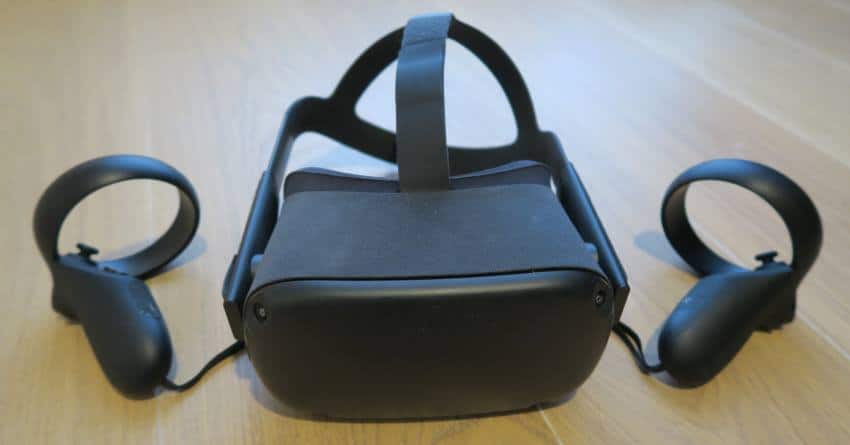
These two have been an absolute hit among customers and Oculus is having trouble producing enough headsets to satisfy the market demand. You can check the current availability and latest price of the Quest from Amazon and Oculus homepage.
The popularity of the headset is no surprise to me. Having owned the Quest from July 2019, I can assure it is just an excellent all-around product that also ticks the required boxes when it comes to kids.
The Quest has manual IPD adjustment, which means that you can adjust the lenses to better fit the eyes of your kids.
The headset is also standalone and can function on its own. This means you can bring the Quest along anywhere you go and start enjoying VR experiences with a single push of a button.
Another plus is that there are no wires to get in the way while playing. This is quite important when it comes to kids who might get a bit more carried away when playing.
However, if you or your child has a decent gaming PC, the Oculus Quest can also function as a PC-tethered VR headset. This enables you to also play more resource-demanding content from the Steam library for example.
I really do think the Quest is the most versatile VR headset on the market now and is a perfect fit for the whole family. Doesn`t matter if you have tried VR before or not – I seriously doubt you will regret the decision if you choose to buy one.
Research and Further Reading
- Immersive Virtual Reality and the Developing Child (Stanford University, 2017)
- Children’s Acquisition of False Memories in Virtual Reality (Stanford University, 2009)
- Effects of Immersive Virtual Reality Headset Viewing on Young Children: Visuomotor Function, Postural Stability, and Motion Sickness (Washington University Medical Center, 2019)
- Virtual Reality 101: What You Need to Know About Kids and VR (Common Sense Media and Stanford University’s Virtual Human Interaction Lab)
- Virtual, Augmented, and Mixed Reality and Kids: Planning Ahead for a Positive Future (VR & AR domain experts, 2019)
- When is it safe to buy kids a VR headset? (TechRadar, 2018)
- Are Virtual Reality Headsets Safe for Eyes? (American Academy of Ophthalmology, 2017)
